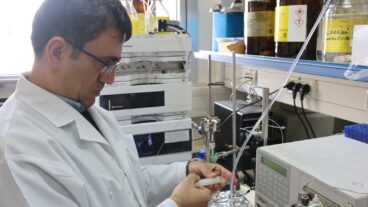Researchers from the Weizmann Institute designed the innovative delivery method that works with the pinpoint accuracy of a smart bomb.Scientists in Israel have destroyed malignant tumors in mice using a chemical that is produced naturally in garlic. Allicin, the compound in garlic responsible for its distinctive aroma and flavor, has been used by the researchers from the Weizmann Institute in Rehovot to selectively destroy cancer cells while leaving healthy cells intact.
The key to their success, the researchers say, lies in the development of a unique, two-step system for delivering allicin straight to the tumor cells.
The team from the institute’s biological chemistry department comprised of Drs. Aharon Rabinkov, Talia Miron and Marina Mironchick, along with Profs. David Mirelman and Meir Wilchek, designed the innovative delivery method that works with the pinpoint accuracy of a smart bomb. Their findings were reported in the December issue of Molecular Cancer Therapeutics.
For years allicin has been touted as responsible for garlic’s benefits, such as its ability to kill bacteria and fight infection. Allicin is produced by an enzymatic reaction when raw garlic is finely chopped or crushed. It gives garlic its distinctive aroma and flavor.
For many years, scientists studying allicin have known that it is as toxic as it is pungent. It has been shown to kill not only cancer cells, but the cells of disease-causing microbes, and even healthy human body cells. Fortunately for our body’s cells, allicin is highly unstable, and breaks down quickly once ingested. However, the rapid breakdown and undiscriminating toxicity presented twin hurdles to creating an allicin-based therapy.
Weizmann researchers have solved both these problems by designing a delivery method that parallels the way allicin is synthesized in nature. First, they developed a way to generate the enzymatic reaction responsible for allicin’s creation at the site of a tumor. Then, to target the tumor, they took advantage of the fact that most types of cancer cells have receptors on their surface. An antibody programmed to recognize the tumor’s characteristic receptor is chemically bound to the enzyme alliinase.
To zero in on the targeted tumor, scientists took advantage of the fact that most types of cancer cells exhibit distinctive receptors on their surfaces. An antibody that is “programmed” to recognize the tumor’s characteristic receptor is chemically bound to the enzyme alliinase. Injected into the bloodstream, the antibody seeks out these cells and lodges itself and its passenger enzyme on the tumor cells. The scientists then inject the second component, alliin, at intervals.
When it encounters the alliinase, the resulting reaction turns the normally inert alliin molecules into lethal allicin molecules, which penetrate and kill the tumor cells.
Thanks to the precise delivery system, healthy cells nearby remain intact. Using this method, the team succeeded in blocking the growth of gastric tumors in mice. The tumor-inhibiting effects were seen up to the end of the experimental period, long after the internally produced allicin was gone.
The scientists note that the method could work for most types of cancer, as long as a specific antibody can be customized to recognize receptors unique to the cancer cells.
The technique could prove invaluable for preventing metastasis following surgery, the researchers claim.
“Even though doctors cannot detect where metastatic cells have migrated and lodged themselves,” says Mirelman, “the antibody-alliinase-alliin combination should chase them down and destroy them anywhere in the body.”
The results of the Weizmann findings have been met with encouragement by experts. Sara Hiom, a science information manager for Cancer Research UK told BBC News Online: “The medicinal properties of garlic have long been recognized. These are encouraging preliminary data. The challenge now will be to develop methods for use against different types of tumor cells and eventually to adapt the technique for use in humans so that the necessary clinical trials can be carried out.”












